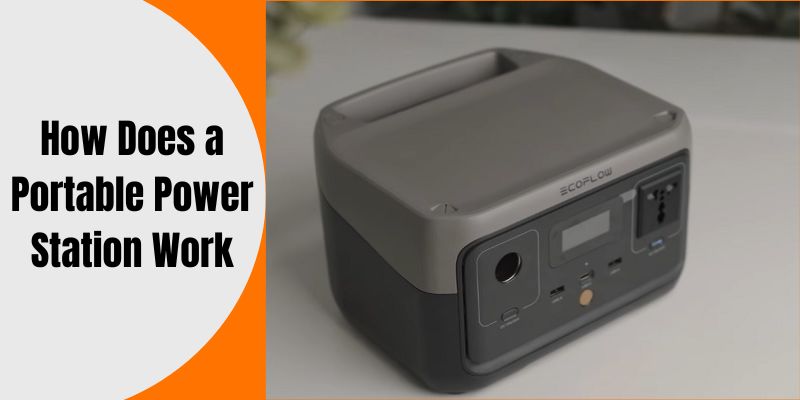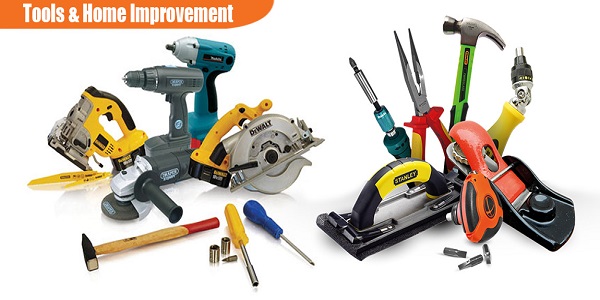Portable power stations work by storing energy for later use. They convert stored energy into usable electricity.
These devices are versatile and convenient, offering power when you need it most. Imagine being able to charge your devices anywhere. Portable power stations make this possible. They store energy from various sources like solar panels or wall outlets. This energy is then used to power gadgets, tools, or appliances.
Whether you’re camping, traveling, or experiencing a power outage, these stations keep you connected. They’re compact and easy to transport, fitting various needs and lifestyles. Understanding how they operate can help you choose the right one for your needs. It’s about knowing how energy is stored and converted efficiently. This knowledge ensures you’re prepared for any situation.

Portable Power Station Basics
A portable power station stores energy in a battery, which can be charged through solar panels, wall outlets, or car chargers. It converts this stored energy into electrical power to run devices like laptops, smartphones, and small appliances. Compact and convenient, it offers a reliable power source during outdoor activities or emergencies.
Portable power stations are becoming indispensable in today’s tech-driven world. They are versatile gadgets that can keep your devices charged on camping trips or provide backup power during emergencies. But how exactly do these handy devices function? Let’s break down the basics to give you a clearer picture of how portable power stations work.
Key Components
A portable power station primarily consists of three key components: the battery, inverter, and charging unit.
The battery is the heart of the power station. It’s often a lithium-ion or lithium-polymer battery that stores energy for later use. This is the same technology found in your smartphone, ensuring a compact and efficient power source.
The inverter plays a critical role by converting the stored DC (direct current) power from the battery into AC (alternating current) power. This conversion is necessary because most household devices operate on AC power.
Lastly, the charging unit allows you to recharge the power station. Whether it’s through a wall outlet, a car charger, or even solar panels, this component ensures that your power station is always ready when you need it.
Primary Functions
The primary function of a portable power station is to provide electricity to your devices when a regular power source is unavailable.
Think about your last camping trip. Did you worry about your phone dying or missing a morning coffee because there was no power? A portable power station solves these issues by powering your gadgets and small appliances, like a coffee maker or a mini fridge, allowing you to enjoy comforts even in remote locations.
Another crucial function is acting as a backup during power outages. Imagine a sudden blackout at home. With a portable power station, you can keep essential devices like your Wi-Fi router or medical equipment running without interruption.
What would you do if faced with a power outage or a weekend adventure with no power source? The flexibility of a portable power station ensures you’re prepared for both.
Consider adding one to your gear, and you might find it as indispensable as your smartphone.

Energy Storage Mechanisms
Understanding how a portable power station stores energy is crucial. This mechanism determines how efficiently it operates. Energy storage in portable power stations relies heavily on batteries. The choice of battery impacts performance and reliability.
Battery Types
Portable power stations commonly use lithium-ion batteries. These batteries are lightweight and have high energy density. They are favored for their efficiency and fast charging capabilities. Another type is lead-acid batteries, known for durability. They are heavier and often found in larger power stations. Nickel-metal hydride batteries are less common but offer decent performance. Each type has unique benefits and drawbacks.
Capacity Considerations
Battery capacity is measured in watt-hours (Wh). It indicates how much energy the battery can store. Higher capacity means longer-lasting power. Capacity influences how many devices you can power simultaneously. Consider your energy needs when evaluating capacity. Portable power stations come with various capacities to suit different needs. Choose a capacity that aligns with your usage frequency.
Charging Methods
Portable power stations offer convenience in charging devices anywhere. They have different methods for charging themselves. Each method suits various situations, making them versatile tools. Let’s dive into the most common charging methods used.
Ac Charging
AC charging uses a wall outlet to recharge the power station. It’s straightforward and widely accessible. Plug the power station into a standard outlet. It quickly begins charging. This method is ideal for home or office settings. The charging speed depends on the power station’s capacity and the outlet’s voltage.
Solar Charging
Solar charging uses sunlight to power the station. This eco-friendly method requires solar panels. Connect the panels to the station and place them under sunlight. It’s perfect for outdoor adventures. Sunny days enhance the charging efficiency. Solar charging takes longer than AC but provides energy independence.
Read Here: Can You Overcharge a Portable Power Station
Power Output Options
Understanding power output options is crucial for portable power station users. These devices offer versatile solutions for different needs. They are engineered to provide electricity in various forms. This flexibility makes them ideal for outdoor adventures or emergency situations. Let’s explore the different power output options available.
Ac Outlets
Portable power stations often include AC outlets. These outlets deliver electricity similar to home wall sockets. You can use them to power household appliances. Items like lamps, fans, or small TVs can be plugged in. It’s convenient for camping trips or power outages. The wattage limit should be checked before use. Some devices might exceed the capacity.
Usb Ports
USB ports are another common feature. They allow you to charge electronic devices. Phones, tablets, and cameras can be easily connected. These ports are perfect for travelers. They eliminate the need for multiple chargers. Fast charging technology might be available. It speeds up charging times significantly. Ensure compatibility with your devices for best results.
Inverter Technology
Portable power stations utilize inverter technology to convert stored DC power into AC power. This transformation allows you to use household devices and appliances anywhere. Compact and convenient, these stations offer reliable energy solutions for outdoor adventures or emergency situations.
Inverter technology is the beating heart of portable power stations. It’s what enables these devices to transform stored energy into a usable form for your gadgets and appliances. Whether you’re camping in the wilderness or enduring a power outage at home, understanding how inverter technology works can empower you to make better choices for your energy needs.
Purpose Of Inverters
Inverters play a crucial role in converting direct current (DC) from the power station’s battery into alternating current (AC). Most household electronics and appliances run on AC, making this conversion essential. Without an inverter, your portable power station wouldn’t be able to power your laptop or microwave.
Think of an inverter as the translator between your power source and your devices. It ensures that the energy stored in your power station is delivered in a form that your devices can use. When you plug in your phone charger, the inverter steps in to convert the energy seamlessly.
Extra 5% Off Coupon: 25EFBFAFF
Types Of Inverters
Not all inverters are created equal. Understanding the different types can help you choose the right portable power station for your needs. There are primarily two types: modified sine wave inverters and pure sine wave inverters.
Modified sine wave inverters are the more affordable option. They work well with simple electronics like phone chargers and lights. However, they might cause issues with sensitive devices or appliances that require a stable power flow, like CPAP machines or audio equipment.
On the other hand, pure sine wave inverters deliver energy that closely matches the AC power from your home outlets. They are ideal for sensitive electronics, ensuring smooth operation without the risk of damage. Although they come at a higher price, the investment pays off if you rely on high-demand gadgets.
Imagine you’re on a road trip with your family, and your child needs their laptop for homework. Choosing a power station with the right inverter ensures you won’t face any annoying interruptions. Which type of inverter would you trust to keep your devices running smoothly on the road?
When selecting a portable power station, consider what you’ll be powering. Are you prioritizing budget or performance? Your choice of inverter can make all the difference in the reliability and efficiency of your power station.
Safety Features
Portable power stations offer essential safety features like short-circuit protection and temperature control. These features help prevent overheating and damage to connected devices. Reliable safety mechanisms ensure safe and efficient energy supply for various electronic gadgets.
A portable power station is an incredible tool for those who need electricity on the go. Whether you’re camping in the wilderness or just want a backup for emergencies at home, understanding its safety features is crucial. These features not only ensure the device operates efficiently but also keep you and your devices safe.
Overload Protection
Have you ever plugged too many devices into a power strip and had it trip? Portable power stations come with overload protection to prevent just that. This feature automatically shuts down the power station if you connect too many devices or if a device demands more power than the station can supply.
Think of it as a guardian angel for your gadgets. It ensures that neither the power station nor your devices are damaged due to excessive power draw. This safety measure is particularly useful when you’re outdoors and can’t easily replace damaged electronics.
Temperature Control
Temperature control is another critical safety feature in portable power stations. These devices can generate a lot of heat, especially during heavy usage. If you’ve ever felt your laptop getting too hot, you know the importance of keeping electronics cool.
Portable power stations often include built-in fans or heat sinks to manage temperature effectively. This feature helps prevent overheating, which can lead to device failure or even fires. It’s comforting to know that the power station is designed to keep its cool, even when you’re pushing it to its limits.
When you plan your next adventure or power outage preparation, remember the safety features that come with your portable power station. They are designed to protect your investment and give you peace of mind. Have you checked if your power station has these essential safety features? It might be time for a quick review.
Applications And Uses
Portable power stations are versatile devices with many practical applications. They provide electricity on-the-go, making life easier in various scenarios. Whether you’re exploring the great outdoors or preparing for emergencies, these devices come in handy. Let’s explore some common uses.
Outdoor Adventures
Portable power stations are perfect for outdoor adventures. They keep your devices charged in remote locations. Imagine camping in the wilderness with no power outlets around. A portable power station can charge your phone, camera, and other essential gadgets. It ensures you capture every moment of your adventure. You can even power your power tools like a chainsaw or a worm drive circular saw. This enhances your outdoor experience by adding comfort and convenience.
Emergency Backup
Having a reliable power source during emergencies is crucial. Portable power stations offer a dependable backup when the electricity goes out. They keep your essential devices running during power outages. This includes lights, medical equipment, and communication devices. In storms or natural disasters, they provide peace of mind. You stay connected and informed, which is vital in emergencies. With a portable power station, you have a lifeline when traditional power sources fail.
Maintenance Tips
Maintaining your portable power station ensures its longevity and optimal performance. Regular care prevents unexpected breakdowns and keeps your device ready for use. It’s crucial to follow specific maintenance tips to extend its life. Understanding these practices helps you avoid costly repairs and replacements.
Regular Check-ups
Regularly inspect your power station’s components for wear and tear. Look for any signs of damage or corrosion. Check the battery level and charge it fully if needed. Ensure all connectors are clean and tightly secured. Verify that the display and buttons function properly. This routine helps identify potential issues early.
Extra 5% Off Coupon: 25EFBFAFF
Proper Storage
Store your power station in a dry, cool place. Avoid direct sunlight and extreme temperatures. Keep it away from moisture and dust. Use a protective cover for added safety. Ensure it is not exposed to unnecessary vibrations. Proper storage extends the life of your device significantly.

Frequently Asked Questions
How Long Will A Portable Power Station Run?
A portable power station typically runs between 5 to 12 hours, depending on its capacity and usage. High-capacity models can last longer, powering devices like laptops, phones, and small appliances efficiently. Always check the manufacturer’s specifications for precise runtimes.
What Are The Disadvantages Of A Portable Power Station?
Portable power stations can be expensive and have limited power capacity. Charging can be slow, especially with solar panels. Their weight may limit portability, and they often require maintenance. Durability can be an issue in harsh environments. Energy output may not suit high-demand devices.
Is It Worth Getting A Portable Power Station?
Yes, a portable power station is worth it. It provides reliable backup power during outages. Perfect for camping, outdoor activities, or emergencies. It offers convenience and peace of mind. Portable power stations are environmentally friendly and reduce reliance on traditional generators.
Consider your power needs to choose the right one.
How Long Will A Portable Power Station Run A Tv?
A portable power station can run a TV for 2 to 10 hours. The duration depends on the TV’s wattage and the power station’s capacity. Calculate the TV’s power consumption and match it with the power station’s watt-hours for an accurate estimate.
Final Words
Portable power stations are handy tools for energy needs. They store electricity efficiently. You can charge them from a wall outlet, car, or solar panel. Use them to power devices during outings or emergencies. They work silently, offering a peaceful solution.
Easy to carry, they fit various activities. Choose one with the right capacity for your needs. Understand its features before buying. Always follow safety guidelines when using. Portable power stations make energy accessible anytime, anywhere. A practical choice for modern lifestyles.
Explore options that suit your requirements. Enjoy the convenience they offer in daily life.


